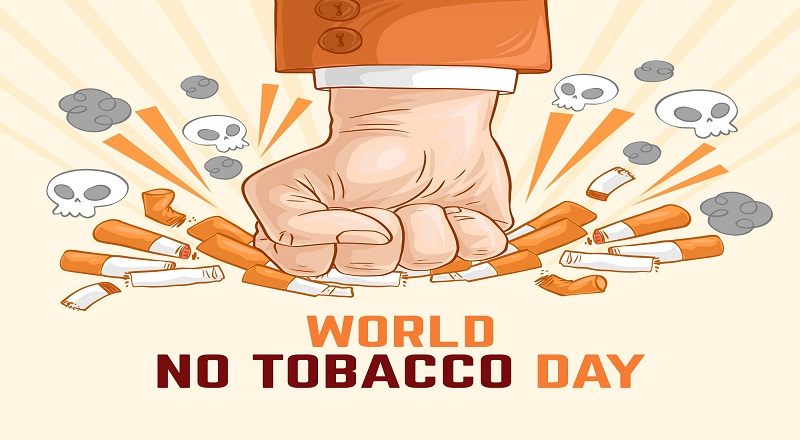Introduction
World No Tobacco Day is observed every year on May 31st to raise awareness about the harmful effects of tobacco and to promote a tobacco-free lifestyle. Tobacco use remains one of the leading causes of preventable deaths worldwide, causing millions of deaths each year. This global campaign aims to educate individuals about the health risks associated with tobacco use, advocate for effective policies to reduce tobacco consumption, and encourage people to quit smoking.
The Health Risks of Tobacco Use
Tobacco use is a major risk factor for a range of diseases, including cancer, cardiovascular diseases, chronic obstructive pulmonary disease (COPD), and respiratory infections. Smoking cigarettes, cigars, pipes, and using smokeless tobacco products all pose significant health risks. The chemicals present in tobacco, such as nicotine, tar, and carbon monoxide, are highly toxic and have detrimental effects on the body.
Cigarette smoking is particularly harmful as it delivers nicotine to the brain within seconds, making it highly addictive. The long-term health consequences of smoking are severe and can lead to lung cancer, heart disease, stroke, and a host of other respiratory and cardiovascular ailments. Secondhand smoke is equally dangerous, affecting not only smokers but also those exposed to the smoke.
The Economic and Social Costs of Tobacco
In addition to the devastating health consequences, tobacco use also carries significant economic and social costs. The healthcare expenses associated with treating tobacco-related illnesses place a substantial burden on healthcare systems and individuals. Tobacco use leads to increased hospitalizations, doctor visits, and medications, straining resources that could be better allocated elsewhere.
Furthermore, tobacco use negatively impacts productivity and contributes to a loss of human capital. Smokers often suffer from reduced work productivity, increased absenteeism, and higher healthcare costs, affecting both individuals and businesses. The toll on families and communities is also substantial, as smoking-related illnesses can lead to financial hardships and emotional distress.
Effective Tobacco Control Measures
To combat the global tobacco epidemic, comprehensive tobacco control measures are crucial. Governments and public health organizations play a vital role in implementing policies that discourage tobacco use and protect public health. Some of the key measures include:
-
Raising tobacco taxes:
Increasing the price of tobacco products through taxation has proven to be an effective deterrent, particularly among young people and low-income populations. Higher prices discourage initiation and encourage smokers to quit.
-
Implementing smoke-free laws:
Enacting and enforcing laws that ban smoking in public places, workplaces, and other shared spaces protect non-smokers from secondhand smoke and promote a smoke-free environment.
-
Educating the public:
Conducting public awareness campaigns to inform individuals about the dangers of tobacco use, the benefits of quitting, and available resources for support.
-
Offering cessation support:
Providing accessible and affordable cessation services, including counseling, medications, and helplines, can greatly increase the success rate of quitting attempts.
Inspiring a Tobacco-Free Lifestyle
World No Tobacco Day serves as a catalyst for inspiring individuals to embrace a tobacco-free lifestyle. Here are some strategies to help individuals quit smoking and stay tobacco-free:
-
Set a quit date and make a plan:
Choose a specific date to quit smoking and develop a personalized quit plan. Identify triggers and develop strategies to cope with cravings and withdrawal symptoms.
-
Seek support:
Inform friends, family, and colleagues about your decision to quit and ask for their support. Joining support groups or seeking professional counseling can provide valuable guidance and encouragement.
-
Find healthier alternatives:
Engage in activities that distract from cravings and replace smoking with healthier habits. Exercise regularly, practice stress-reducing techniques like meditation or yoga, and indulge in hobbies that bring joy and fulfillment.
-
Celebrate milestones:
Acknowledge and celebrate milestones along the journey to a tobacco-free life. Reward yourself for achieving short-term goals, such as a smoke-free week or month, to stay motivated.
Conclusion
World No Tobacco Day serves as a reminder of the urgency to address the global tobacco epidemic. By raising awareness about the health risks, economic burdens, and effective tobacco control measures, we can inspire individuals to choose a tobacco-free lifestyle. Quitting smoking is challenging, but with the right support, determination, and resources, it is possible to break free from the grip of tobacco addiction. Let us join hands in promoting a healthier future, free from the harms of tobacco, and work towards building a world where every day is a tobacco-free day.



